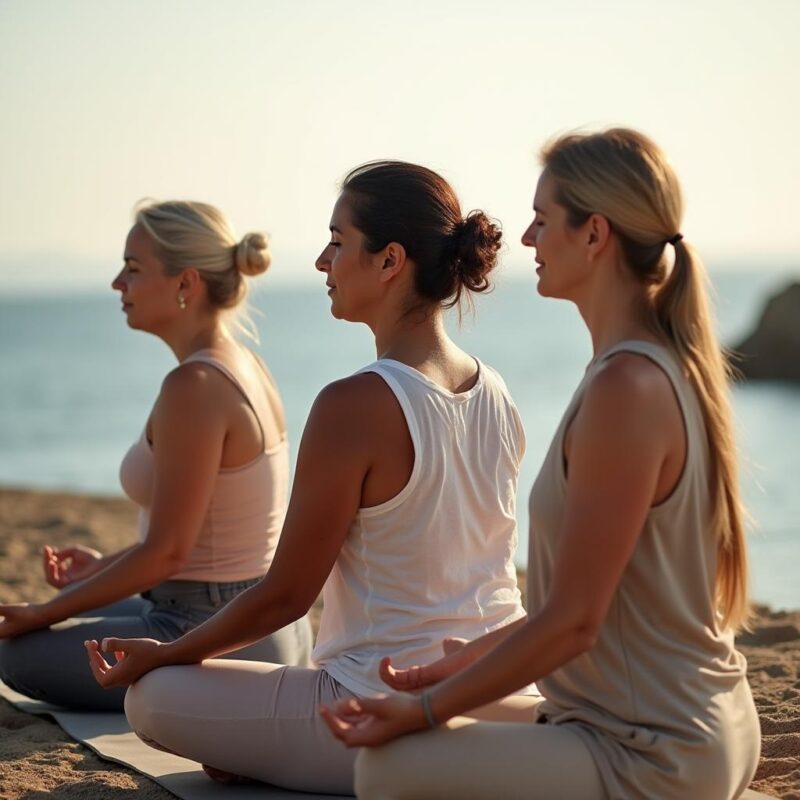The Power of Breath: Breathwork Techniques for Stress Relief
Take a moment to notice your breath. Are you breathing deeply and fully, or are your breaths shallow and rapid? In each moment, your breath is a constant companion, a vital force that sustains life. Yet, we often take it for granted, unaware of its incredible potential to influence our mental, emotional, and physical states.
Conscious breathwork, the practice of intentionally manipulating your breathing patterns, is a powerful tool for unlocking inner peace, boosting energy levels, and promoting overall well-being. This article will explore the science of breath and provide practical techniques to harness its transformative power.

“Your breath is a powerful tool that you can use to influence your mental, emotional, and physical states.”
The Physiology of Breath:
- The respiratory system is responsible for the exchange of oxygen and carbon dioxide in the body. Oxygen is essential for cellular function, while carbon dioxide is a waste product that needs to be expelled.
- Breathing is also intimately connected to the autonomic nervous system, which controls involuntary bodily functions. The autonomic nervous system has two branches:
- The sympathetic nervous system (SNS), also known as the “fight-or-flight” response, prepares the body for action in stressful situations. It increases heart rate, blood pressure, and breathing rate. Shallow, rapid breathing is often associated with SNS activation.
- The parasympathetic nervous system (PNS), also known as the “rest-and-digest” response, promotes relaxation and conserves energy. Deep, slow breathing activates the PNS, leading to a calming effect on the body and mind.
- By consciously altering our breathing patterns, we can directly influence the balance between the SNS and PNS, thereby impacting our stress levels, energy levels, and emotional state.

Breathwork Techniques for Specific Outcomes:
4-6 Breathing
- 4-6 breathing is a simple yet powerful technique that involves a slightly extended exhale to promote relaxation and shift the nervous system into a calmer state.
- How to:
- Inhale slowly through your nose for a count of 4.
- Exhale slowly through your mouth for a count of 6.
- Continue this cycle, making the exhale slightly longer than the inhale.
- Why it works:
- This breathing technique is particularly effective for shifting the nervous system from sympathetic dominance (fight-or-flight) to parasympathetic dominance (rest-and-digest).
- The slightly extended exhale helps to slow the heart rate and calm the mind, promoting relaxation and reducing feelings of anxiety or stress.
- Benefits:
- Stress reduction.
- Anxiety relief.
- Improved focus.
- Emotional regulation.
- Tips for use:
- Use this technique whenever you feel stressed, anxious, or overwhelmed.
- It can be practiced anytime, anywhere, and can be especially helpful before bed to promote restful sleep.
- How to:
Box Breathing
-
Box breathing, also known as square breathing, is a simple yet effective technique for promoting focus and balance.
- How to:
- Inhale slowly through your nose for a count of 4.
- Hold your breath for a count of 4.
- Exhale slowly through your mouth for a count of 4.
- Hold your breath out for a count of 4.
- Repeat this cycle for several minutes.
- Why it works: Box breathing helps to regulate the nervous system, bringing it into a state of equilibrium. It can be used to calm anxiety, improve concentration, and enhance overall mental clarity.
- Real-life applications: Box breathing can be used in various situations, such as managing test anxiety, improving athletic performance, or simply taking a moment to center yourself during a busy day.
- How to:
4-7-8 Breath
-
The 4-7-8 breath is a powerful technique for promoting relaxation and reducing anxiety, and improving sleep.
- How to:
- Exhale completely through your mouth, making a whooshing sound.
- Inhale quietly through your nose for a count of 4.
- Hold your breath for a count of 7.
- Exhale slowly through your mouth for a count of 8, making a whooshing sound.
- Repeat this cycle at least four times.
- Why it works: The 4-7-8 breath is believed to calm the nervous system by increasing parasympathetic activity. The longer exhale is thought to slow down the heart rate and promote relaxation.
- Tips for use: This technique is particularly effective for falling asleep or managing anxiety.
- How to:
Ujjayi Breath
-
Ujjayi breath, also known as “Oceanic Breath” or “Victorious Breath,” is a technique commonly used in yoga practice.
- How to:
- Inhale and exhale through your nose while slightly constricting the back of your throat, as if you were whispering “ha.”
- This creates a soft, hissing sound similar to the sound of ocean waves.
- Maintain this gentle constriction throughout the breath.
- Why it works: Ujjayi breath generates internal heat, increases oxygen flow, and cultivates a sense of presence. It can be energizing and calming at the same time.
- Connection to yoga: Ujjayi breath is often used in yoga to synchronize breath with movement, creating a meditative and flowing practice.
- How to:
Integrating Breathwork into Daily Life:
- Establish a Practice:
- Start with just 5-10 minutes of breathwork per day and gradually increase the duration as you become more comfortable.
- Choose a quiet time and place where you won’t be interrupted.
- Consistency is key. Even short, regular practice can yield significant benefits.
- When and Where to Practice:
- Breathwork can be practiced anytime and anywhere.
- Use it to start your day with energy, to manage stress during work, or to wind down before bed.
- You can practice while sitting, lying down, or even walking.
- Addressing Challenges:
- It’s normal to experience some discomfort or distraction when you first start practicing breathwork.
- Be patient with yourself, and gently redirect your attention back to your breath whenever your mind wanders.
- If you experience any dizziness or lightheadedness, stop and return to normal breathing.

“Conscious breathwork can shift your nervous system from stress to relaxation, promoting inner peace and boosting energy.”
“By learning to control your breath, you can unlock a greater sense of calm, focus, and vitality in your daily life.”
Begin Your Transformative Journey
Your breath is a powerful tool for transformation. By learning to control and manipulate your breathing, you can reduce stress, increase energy, cultivate inner peace, and enhance your overall well-being.
Discover the life-changing potential of conscious breathing in our Guided Breathwork for Inner Peace & Calm workshop at Balanced by the Isle. Our experienced facilitators will guide you through practical techniques to manage stress, balance your emotions, and unlock your inner vitality.
|
|
Click here to learn more about our retreat and embark on a journey to a more balanced and energized you.
